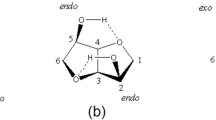Abstract
Phosphorus compounds derived from renewable biomaterials are of increasing interest as polymer additives. These compounds may have both a plasticizing and flame-retarding effect on a polymer matrix into which they are incorporated. The thermal degradation of a series of phosphorus esters derived from a diol generated by the esterification of isosorbide (from starch) with 10-undecenoic acid (from castor oil) followed by thiol-ene reaction with 2-hydroxyethanethiol has been examined using thermogravimetry and infrared spectroscopy. All the esters undergo degradation over the temperature range of 250–310 °C to generate a substantial residual char. Infrared analysis of samples undergoing degradation suggests that a prominent reaction is elimination of a phosphorus acid.





















Similar content being viewed by others
References
Reddy MR, Vivekanandhan S, Misra M, Bhatia SK, Mohanty AK. Biobased plastics and bionanocomposites: current status and future opportunities. Prog Polym Sci. 2013;38:1653–89.
Malinconico M, Cerruti P, Santagata G, Immirzi B. Natural polymers and additives in commodity and specialty applications: a challenge for the chemistry of the future. Macromol Symp. 2014;337:124–33.
Soroudi A, Jakubowicz I. Recycling of bioplastics, their blends and biocomposites: a review. Eur Polym J. 2013;49:2839–58.
Doppalapudi S, Jain A, Khan W, Domb AJ. Biodegradable polymers—an overview. Polym Adv Technol. 2014;25:427–35.
Chen GQ, Patel MK. Plastics derived from biological sources: present and future: a technical and environmental review. Chem Rev. 2012;112:2082–99.
Tschan MJL, Brule E, Hapquette P, Thomas CM. Synthesis of biodegradable polymers from renewable resources. Polym Chem. 2012;3:836–51.
Shen L, Haufe J, Patel MK. Product overview and market projection of emerging bio-based plastics, PRO-BIP 2009. Utrecht: Utrecht University; 2009.
van der Veen I, de Boer J. Phosphorous flame retardants: properties, production, environmental occurrence, toxicity and analysis. Chemosphere. 2012;88:1119–53.
Morris PJ, Medina-Cleghorn D, Heslin A, King SM, Orr J, Mulvihill MM, Krauss RM, Nomura DK. Organophosphorus flame retardants inhibit specific liver carboxylesterases and cause serum hypertriglyceridemia. ACS Chem Biol. 2014;. doi:10.1021/cb500014r.
Eede N, Neels H, Jorens PG, Covaci A. Analysis of organophosphate flame retardant diester metabolites in human urine by liquid chromatography electrospray ionization tandem mass spectrometry. J Chromatogr A. 2013;1303:48–53.
Meeker JD, Stapleton HM. House dust concentrations of organophosphate flame retardants in relation to hormone levels and semen quality parameters. Environ Health Perspect. 2010;118:318–23.
Salamova A, Ma Y, Venier M, Hites RA. High levels of organophosphate flame retardants in the Great Lakes atmosphere. Environ Sci Technol Lett. 2014;1:8–14.
Howell BA, Dangalle H. Phosphorus-containing tartrates and hydroquinones as flame retardant precursors. In: Proceedings, 39th annual technical meeting of the North American Thermal Analysis Society. 2011.
Alace M, Wenning RJ. The significance of brominated flame retardants in the environment: current understanding, issues and challenges. Chemosphere. 2002;46:579–82.
Darnerud PD. Brominated flame retardants as possible endocrine disrupters. Int J Androl. 2008;31:152.
Herbstmann JB, Sjödin A, Kurzon M, Lederman SA, Jones RS, Rauh V, Needham LL, Tang D, Nieazwiecki M, Wang RY, Perera F. Prenatal exposure to PBDEs and neurodevelopment. Envrion Health Perspect. 2010;118:712–9.
Hess G. Industry drops flame retardant. Chem Eng News. 2010;88(1):10.
Narayan S, Moore M. Flame retardants—a new, versatile flame retardant for olefinic and styrenic polymers. Popul Plast Packag. 2012;75(3):58–60.
Daniel YC, Howell BA. Isosorbide as a renewable biosource for phosphorus-based flame retardants. In: Proceedings, 2012 IUPAC World Polymer Congress. 2012.
Feng X, East AJ, Hammond WB, Zhang Y, Jaffe M. Overview of advances in sugar-based polymers. Polym Adv Technol. 2011;22:139–50.
Rose M, Palkovits R. Isosorbide as a renewable platform chemical for versatile applications—quo vadis? ChemSusChem. 2012;5:167–76.
Fenouillot F, Rosseau A, Colomines G, Saint-Loup R, Pascault JP. Polymers from renewable 1,4;1,6-dianhydrohexitols (isosorbide, isomannide and isoiodide): a review. Prog Polym Sci. 2010;25:578–622.
von der Steen M, Stevens CV. Undecylenic acid: a valuable and physiologically active renewable building block from castor oil. ChemSusChem. 2009;2:692–713.
de Espinosa LM, Meier MAK. Plant oils: The perfect renewable resource for polymer science?! Eur Polym J. 2011;47:837–52.
Biermann U, Bornscheurer U, Meier MAR, Metzger JO, Schafer HJ. Oils and fats as renewable raw materials in chemistry. Angew Chem Int Ed. 2011;50:3854–71.
Gilbert EE. The unique chemistry of castor oil. J Chem Educ. 1941;18:338.
Atabani AE, Silitonga AS, Ong HC, Mahlia TMI, Masjuki HH, Badruddin IA, Fayaz H. Non-edible vegetable oils: a critical evaluation of oil extraction, fatty acid compositions, biodiesel production, characteristics, engine performance and emissions production. Renew Sustain Energy Rev. 2013;18:211–45.
Howell BA, Carter KE, Dangalle H. Flame retardants based on tartaric acid: a renewable by-product of the wine industry. In: Payne GF, Smith PB, editors. Renewable and sustainable polymers (ACS symposium series 1063), American Chemical Society, Washington, 2011, Ch. 9, p. 133–152.
Lowe AB. Thiol-ene “click” reactions and recent applications in polymer and materials synthesis. Polym Chem. 2010;1:17–36.
Grigor BB, James AK, Girma B, Moon GH. Free radical addition of butanethiol to vegetable oil double bonds. J Agric Food Chem. 2009;57:1282–90.
Maisonneuve L, Lebarb T, Nga Nguyen TH, Cloutlet E, Gadenne B, Alfos C, Cramail H. Hydroxyl telechelic building blocks from fatty acid methyl esters for the synthesis of poly(ester/amide urethane)s with versatile properties. Polym Chem. 2012;3:2583.
Dumitrascu A, Howell BA. Flame-retarding vinyl polymers using phosphorus-functionalized styrene monomers. Polym Degrad Stab. 2011;96:342–9.
Thomas LC. Interpretation of the infrared spectra of organophosphorus compounds. London: Academic Press; 1974.
Thomas LC, Chittenden RA. Characteristic infrared absorption frequencies of organophosphorus compounds I. The phosphoryl group. Spectrochim Acta. 1964;20:467–87.
Daasch LW, Smith DC. Infrared spectra of phosphorus compounds. Anal Chem. 1951;23:853–68.
Acknowledgements
Support of this work by Chemtura Corporation/Great Lakes Solutions is gratefully acknowledged. A sample of diphenyl chlorophosphate was graciously provided by ICL-IP America.
Author information
Authors and Affiliations
Corresponding author
Rights and permissions
About this article
Cite this article
Howell, B.A., Daniel, Y.G. Thermal degradation of phosphorus esters derived from isosorbide and 10-undecenoic acid. J Therm Anal Calorim 121, 411–419 (2015). https://doi.org/10.1007/s10973-015-4487-2
Received:
Accepted:
Published:
Issue Date:
DOI: https://doi.org/10.1007/s10973-015-4487-2




